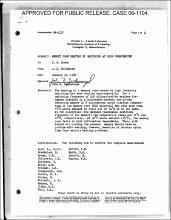Memory core heating by switching at high frequencies
Childress, J. D.

DownloadMC665_r16_M-4137.pdf (1015.Kb)
Date
1956-01-31Abstract
The heating of a memory core caused by high frequency
switching has been studied experimentally. For a
switching frequency of 4OO kilocycles (the maximum frequency possible in a coincident-current two-to-one
selection memory of 5 microsecond cycle time) the temperature of the memory core (DCL material) may rise more than 57 C above ambient in still air or 34 C in an oil bath.
At 200 kilocycles (the maximum reasonable switching frequency in the memory) the temperature rises are 33 C and 22 C, respectively. At 30 C above ambient (25 C), the memory
core fails to hold information dependably. Thus, with
forced air cooling the present memory should have no
problem with heating; however, memories of shorter cycle
time face serious heating problems.
Description
Includes: introduction, experimental procedure, discussion, conclusions, and charts.